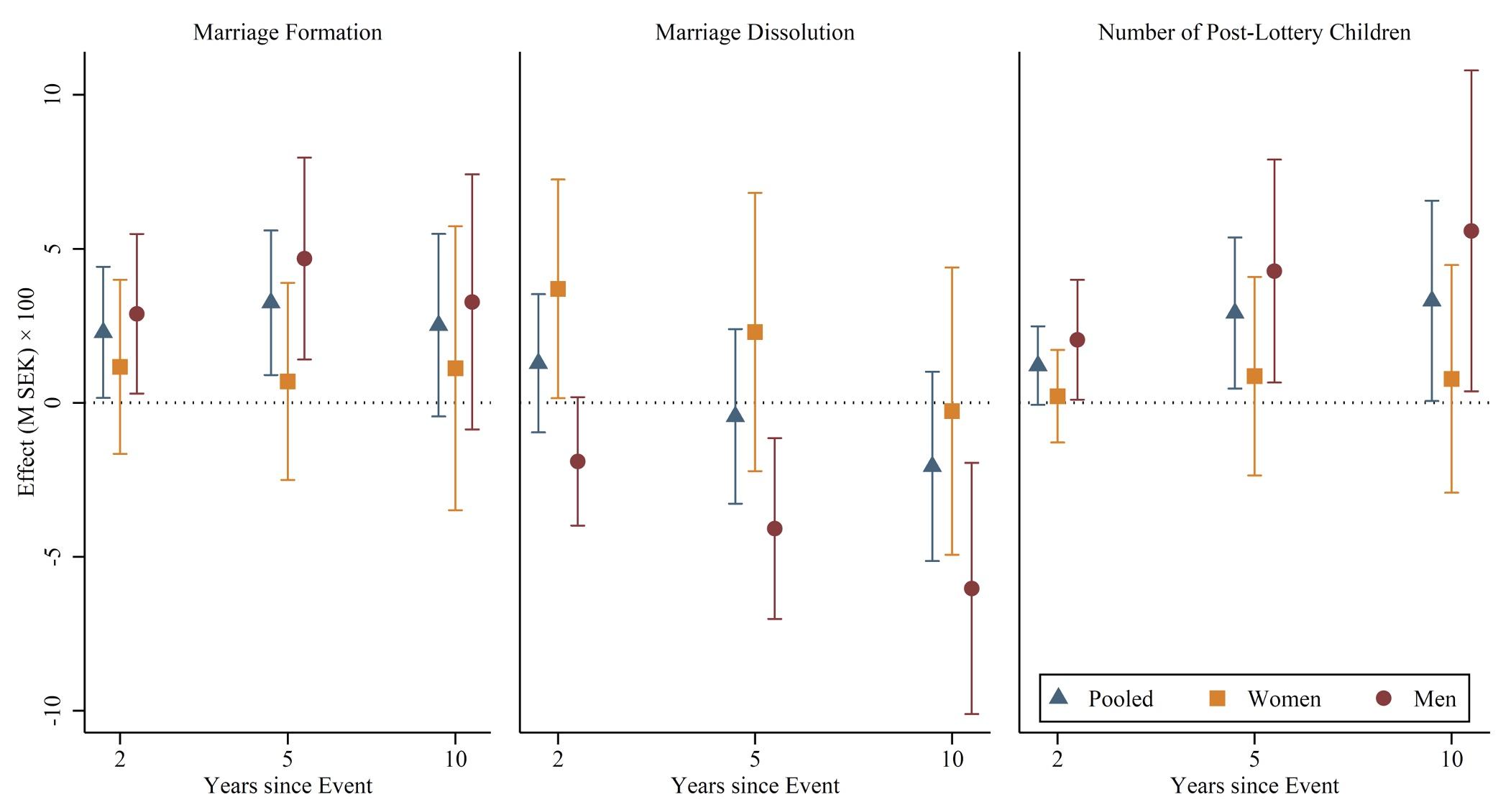Fertility rates in most European countries have fallen below the replacement rate, and policymakers are striving to implement policies that boost fertility (Kindermann and Doepke 2016). A natural starting point for thinking about such policies is the pioneering work of Gary Becker, who introduced family decisions such as fertility and marriage into standard economic models, allowing for clear predictions about how fertility and marriage respond to changes in prices, income, or wealth (e.g. Becker 1960). However, predictions and policy implications of family economics models hinge on underlying assumptions. For example, Becker’s famous assumption that “children are normal goods” implies that positive shocks to unearned income will be associated with higher fertility, suggesting that interventions such as unconditional cash transfers or universal basic income could boost fertility. Another common assumption is that spouses pool their incomes. This assumption implies that because family behaviour depends on total family income, it will not matter which spouse receives a transfer.
Although Becker’s work has contributed to a vast body of literature on family economics, rigorously testing its fundamental assumptions has proved challenging. There is an inherent difficulty in estimating the causal effects of income and wealth on family decisions. Since marriage and fertility decisions, as well as labour market or saving decisions, are made simultaneously, it is not easy to find exogenous variation in observational data. In a recent study using a large administrative dataset of Swedish lottery players (Cesarini et al. 2023), we try to better understand causality by estimating the impact of significant unearned financial windfalls on fertility, marriage formation, and divorce risk.
Lottery wealth and family formation
The idea of using lottery prizes to obtain exogenous variation in wealth for causal effect estimation is not new. Imbens et al. (2001) used lottery data to estimate the causal impact of unearned income on labour income, savings, and consumption. However, our data has several advantages compared to other lottery data. First, we observe the factors on which the assignment of lottery wealth is contingent (type of lottery, lottery draw, number of tickets). This allows us to compare winners of large and small prizes who participated under the same conditions and thus had an equal chance of winning a large prize. In fact, we show that once we condition on lottery characteristics, the size of the prize is as good as random. Second, the dataset combines different lotteries, and the total prize pool in our sample of 90,000 winners aged 18–44 amounts to approximately $250 million. Third, Sweden’s high-quality administrative data enables us to observe yearly records of childbirths, marriages, divorces, even cohabitation for an extended period following the lottery. This data has been used previously by Cesarini et al. (2016, 2017) and Lindqvist et al. (2020) to examine the effects of unearned wealth on health and child development, labour supply, and subjective wellbeing.
We focus on three primary outcomes: the number of children born after winning the lottery, whether unmarried winners marry, and divorces among married winners. We analyse these outcomes separately for men and women at two, five, and ten years after their lottery win. Overall, the estimates suggest that unmarried lottery players who unexpectedly receive a substantial windfall are more likely to get married (Figure 1). Specifically, the estimates imply that a million Swedish krona (SEK) – which corresponds to $150,000 or approximately 4.5 years of average annual disposable income in Sweden – increases the probability of getting married two, five, and ten years after the lottery by 2.3, 3.3, and 2.5 percentage points, respectively, which corresponds to approximately 25%, 20%, and 9% change with respect to average marriage rates. Fertility also increases as a result of winning the lottery: we estimate that a one million SEK windfall increases the number of children by 0.01 to 0.03 within two to ten years after winning. Approximately 40% of the fertility effect can be attributed to an increase in marriages. For married players, we find that the overall effect on divorce is small and statistically indistinguishable from zero.
Figure 1 Wealth and family formation
Notes: This figure reports the estimated treatment effects of one million SEK on the probability of getting married for unmarried players, on the probability of getting divorced for married players, and on the number of post-lottery children – all measured at years’ end two, five, and ten years after the lottery.
The positive fertility effect is consistent with Becker’s assumption that children are normal goods, as well as with previous quasi-experimental studies that examined wealth changes resulting from housing market fluctuations (Lovenheim and Munford 2013). Although our findings suggest that policies like unconditional cash transfers or similar measures that increase family income could have a positive impact on fertility, the estimated effects are small in magnitude, indicating that the overall impact of these policies on fertility is likely to be modest.
Do men and women respond similarly to the wealth shocks?
When we split the sample by gender, we find that men and women respond differently to the wealth shock. For men, the results suggest positive effects on marriage and fertility; for women, the effects are close to zero. The finding that lottery winnings increase the probability that men will marry is consistent with the general pattern that men tend to have higher economic status compared to their wives in the overall population (e.g. Almås et al. 2023 for evidence based on Norwegian data). In the presence of such hypergamy, higher-income men have a larger pool of potential partners, suggesting that wealth may increase their chances of finding a suitable match.
In our analysis of divorces, we document a notable gender disparity that is inconsistent with income pooling. Figure 1 illustrates that the wife’s lottery wealth increases her short-term divorce risk, but this effect diminishes over time. This suggests that the wife’s positive wealth shock accelerates her exit from a marriage whose dissolution was already underway. A lottery prize may provide certain married women with the financial resources to pursue independence. In line with this explanation, we find that the spike in divorces when married women win the lottery is only present for couples in which the woman earns relatively little. By contrast, a positive wealth shock for the husband reduces the risk of divorce, and this effect persists in the long run. These results are compatible with previous evidence showing that increasing a husband’s income or employment decreases his divorce risk, while an increase in wives’ income or employment has the opposite effect (e.g. Folke and Rickne 2020). Although we believe the most parsimonious explanation of our findings is gender differences in preferences, we cannot rule out gender norms as a potential mechanism (Pan et al. 2016).
Conclusion
The totality of evidence indicates that unearned wealth influences marital, divorce, and fertility decisions. Information about the size and magnitude of wealth effects is potentially useful for evaluating policies that generate substantial changes in the distribution of wealth, such as major changes in welfare programmes, capital taxation, or the adoption of a universal system of basic income. A comprehensive evaluation of such a policy change should ideally consider any effects of the proposed wealth transfers on other outcomes of interest, including fertility and marriage. Our analysis of gender-specific effects is also informative for policy interventions that aim to increase the relative income of women versus men. Particularly, transfers targeted to women may increase their bargaining power within the household and help them leave a destructive marriage (Carneiro et al. 2016).
References
Almås, I, A Kotsadam, E R Moen and K Røed (2023), “The economics of hypergamy”, Journal of Human Resources 58(1): 260–281.
Becker, G S (1960), “An economic analysis of fertility”, in Demographic and economic change in developed countries, Columbia University Press, 209–240.
Carneiro, P, A Armand, O Attanasio and I Almås (2016), “Targeted transfers and the assessment of women’s empowerment”, VoxEU.org, 26 March.
Cesarini, D, E Lindqvist, M J Notowidigdo and R Östling (2017), “The effect of wealth on individual and household labor supply: evidence from Swedish lotteries”, American Economic Review 107(12): 3917–3946.
Cesarini, D, E Lindqvist, R Östling and A Terskaya (2023), “Fortunate Families? The Effects of Wealth on Marriage and Fertility”, NBER Working Paper No. 31039.
Cesarini, D, E Lindqvist, R Östling and B Wallace (2016), “Wealth, health, and child development: Evidence from administrative data on Swedish lottery players”, The Quarterly Journal of Economics 131(2): 687–738.
Folke, O and J Rickne (2020), “All the single ladies: Job promotions and the durability of marriage”, American Economic Journal: Applied Economics 12(1): 260–287.
Imbens, G W, D B Rubin and B I Sacerdote (2001), “Estimating the effect of unearned income on labor earnings, savings, and consumption: Evidence from a survey of lottery players”, American Economic Review 91(4): 778–794.
Kindermann, F and M Doepke (2016), “Why European women are saying no to having (more) babies”, VoxEU.org, 3 May.
Lindqvist, E, R Östling and D Cesarini (2020), “Long-run effects of lottery wealth on psychological well-being”, The Review of Economic Studies 87(6): 2703–2726.
Lovenheim, M F and K J Mumford (2013), “Do family wealth shocks affect fertility choices? Evidence from the housing market”, Review of Economics and Statistics 95(2): 464–475.
Östling, R, E Lindqvist, M Notowidigdo and D Cesarini (2016), “Using the labour supply responses of lottery winners to evaluate tax and transfer policies”, VoxEU.org, 24 January.
Pan, J, P Cortes, C Olivetti and M Bertrand (2016), “When social norms and women’s opportunities interact: Effects on women’s marriage prospects by education”, VoxEU.org, 21 June.






